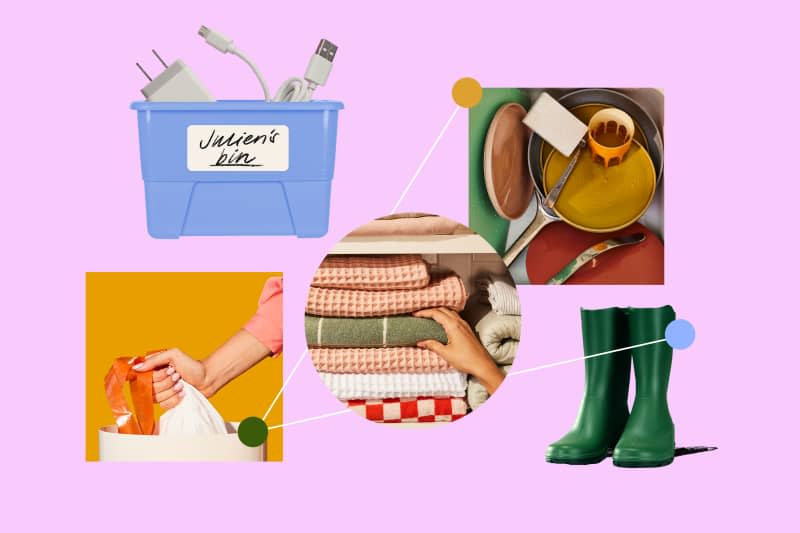The “5 Things Method” Can Make Cleaning Feel More Manageable

When your home is a big mess, where every surface seems to be covered in stuff and you can’t remember what color the rug is, it can feel impossible to pick it all up. But what can help make it feel more manageable is to clean using the “five things method.” According to KC Davis, a licensed professional therapist and the author of How to Keep House While Drowning, you really only have to deal with five types of messes in your home: trash, dishes, laundry, things that have a place, and things that don’t have a place.
By thinking of your mess this way, you’ll be able to sort things into groups before you begin tidying, making it more manageable and less overwhelming. “You can see progress really quickly going this way,” explains Davis. “And the pleasure center of your brain responds to seeing that progress, and then that progress becomes the motivation.”
Of course, the other advantage of the five things method is that it is both simple to implement and endlessly applicable. Cleaning, tidying, and other home maintenance tasks make up part of the invisible mental load, but having routines and strategies can free up some of that brain space for more important matters.
So take a deep breath. Remind yourself that a messy home just means that you’ve been living a full life there — and start by tackling the first mess.
How to use the five things method
Here’s how you can implement the five things method to clean up your home.
Tackle the first three types of messes: trash, dishes, and laundry
First, put all the trash in a trash bag and leave it by the door. Then, put the dishes into the sink. Next, put the laundry in a basket and leave it by the washer. Pick these up first, but don’t deal with them just yet. By picking up each of these things from the space and getting them contained, you can start to see progress quickly because you’re not getting held up with the details. The other benefit to this specific order is that you’re getting the things that are potential hygiene hazards out of the space fast.
Then, address things that have a place
Once you’ve moved your trash, dishes, and laundry out of the space, you should be left with your things. The bits, pieces, and belongings that fill up your home. These things fall into two categories, so gather up two separate piles or containers. Again, don’t deal with them until the end.
Start with things that have a place. Say, the light bulbs go in a basket in your closet. The kids’ toys go in a box in their room. The shoes go by the front door. “When we’re thinking about things that have a place, it’s just something that you already have a storage plan for,” says Davis. “It’s a thing where I don’t have to sit there and decide where it should go.”
And lastly, things that don’t have a place
Finally, pick up and put in a pile or a container anything that doesn’t have a place. These are the items where you find yourself thinking “Well, where should I put this?” and get into a lot of decision-making — which can then spawn other decisions.
This could include new things that don’t have a home yet or items that are in frequent use and haven’t had a permanent home until now. For things that don’t have a place yet, but don’t belong to you personally (say, your partner’s spare phone charger, your kid’s new game, or your roommate’s shoes), you can assign bins, baskets, or containers to those people and make it their responsibility to empty those containers regularly.
What to do after picking up the five messes
Once you have your five messes contained, then you can go back and deal with them. You don’t have to do all of this in one day, though. Start by dealing with things in the same order you picked them up: trash, then dishes, followed by laundry, then things that have a place, and finally things that don’t have a place.
As you become accustomed to the method, though, Davis recommends you adjust it to suit your own needs and preferences. Ask yourself: “What part of this am I feeling resistance to? What part of this am I dreading?” From there, you can figure out how to handle it. For instance, Davis hates dishes, so she always leaves the dishes until the very end, but other people might prefer to do their worst task first because it’s all easier from there. You could also delegate or barter chores with a partner or roommate, like offering to do the laundry if they do the dishes.
Davis recommends leaving the things that don’t have a place until the very end, though. “When you first start doing this your pile of things that don’t have a place is going to be huge,” warns Davis. She has a few strategies for dealing with that: You might sit down with a Netflix show or a podcast and make it a project to find everything a place right now.
Maybe, now that it’s livable, you’ll put all those things without a place into a box and come back to it as a big project in a few days. But you also don’t have to do it all at once. Every time you tidy, try to find permanent homes for three items, and the more you tidy, the smaller that pile will become.
So the next time you feel overwhelmed by the sheer amount of stuff you have to tidy up, just remember: There are only five types of messes.